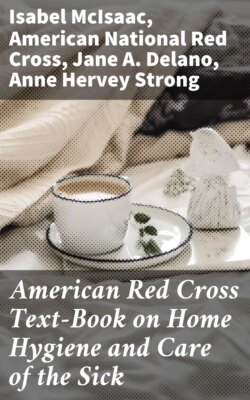Читать книгу American Red Cross Text-Book on Home Hygiene and Care of the Sick - American National Red Cross - Страница 30
На сайте Литреса книга снята с продажи.
Cleanliness of Houses.
Оглавление—A clean, well-cared for house is desirable from every point of view, but certain kinds of cleanliness affect health more than others.
The most scrupulous care should be exercised wherever food is stored or prepared. The kitchen is in reality a laboratory; in it either intelligently or ignorantly are formed chemical compounds which have a far-reaching effect upon family health. From the standpoint of health no other room in the house is so important. It should be bright, airy, and easy to clean. In cleaning kitchen tables and woodwork water should not be allowed to soak into cracks and dark corners, carrying with it particles of food for the nourishment of bacteria and insects. Linoleum, if used to cover the floor, should be well fitted at the edges to prevent water from running underneath. There should be neither cracks nor crevices in wall or floor, and no dark corners or out-of-the-way cupboards in which dust, food particles, and moisture can accumulate. Such conditions not only attract mice and roaches, but furnish favorable soil for the development of moulds and fungi which by their growth affect food deleteriously. Waging a constant warfare against the development of bacteria constitutes a large part of good housekeeping.
All cooking utensils should be thoroughly washed, scalded, and dried before they are put away; the use of carelessly washed dishes is bad. Enameled or agate ware which has begun to chip should be discarded. Dish-cloths and towels should be washed and boiled after using, and if possible dried in the sun.
Every place in which food is kept should have constant care. The refrigerator is particularly important. Its linings should be water-tight, and the drain freely open at all times; otherwise the surrounding wood will become foul and saturated with drainings. At least once a week it should be entirely emptied and cleaned in the following way: The racks should be thoroughly washed in hot soapsuds to which a small amount of washing soda has been added, rinsed in boiling water, dried and placed in the sun and air. All parts of the refrigerator should be washed in the same manner, especially grooves and projections where food or dirt may lodge. The drainpipe should be flushed, the whole interior rinsed again with plain hot water, thoroughly dried with a clean cloth, and left to air for at least an hour. The drainage pan should be washed and scalded frequently. Food showing the slightest evidence of spoiling should be removed from the refrigerator at once.
Even more attention should be paid to the hands of the cook. They should be washed always before handling food, and always after visiting the toilet, using the handkerchief, or otherwise coming in contact with nose, mouth, or other bodily secretions. Theoretically coughing and sneezing ought not to occur in the neighborhood of food, especially of food to be eaten raw; and persons with coughs, colds, or other communicable disease, however slight, ought not to handle food. If this rule were observed in practice, more persons would go hungry, but fewer would be sick.
Thorough cleaning of rooms involves soap, water, sunshine, air, and elbow grease, just as it did before germs were discovered. Cleaning means actually removing dirt and dust, not merely stirring it up to settle again; consequently dry sweeping and dusting are ineffectual. Vacuum cleaning, and sweeping and dusting with damp or "dustless" mops and dusters are good. Deodorants and disinfectants do not take the place of ordinary cleanliness.
Dust does not carry living disease germs to an appreciable extent; the fact is now well established that diseases formerly thought to be transmitted by dust or even supposed to travel directly through the air, are carried on tiny particles of moisture and mucus expelled in coughing and sneezing. This mode of transmission is called droplet or spray infection; it is one of the most active agents in spreading certain kinds of communicable diseases.
Nevertheless dust in motion is harmful; it irritates the lining membranes of the nose, throat, bronchial tubes, and lungs, even causing tiny wounds through which disease germs enter. Thus tuberculosis is especially prevalent among stone cutters, felt workers, and others engaged in dusty trades. Metallic dust is especially harmful, because it is harder and sharper than dust from organic substances like wool and cotton. Furthermore, presence of dust indicates a low standard of cleanliness. People who tolerate it generally tolerate uncleanliness in other forms, more serious though less apparent.
Cleaning would not be so great a problem if most houses were not littered with such dust catchers as carpets, so-called ornaments, carved and upholstered furniture, banners, draperies, and a vast collection of articles that can only be classified as Christmas presents. In actual practice things that are difficult or expensive to clean seldom are cleaned; carpets for example are considered unhygienic, not because they cannot be cleaned, but because they are not. William Morris' advice to exclude from houses all articles not known to be useful or believed to be beautiful would, if followed, add years to the lives of housekeepers.
